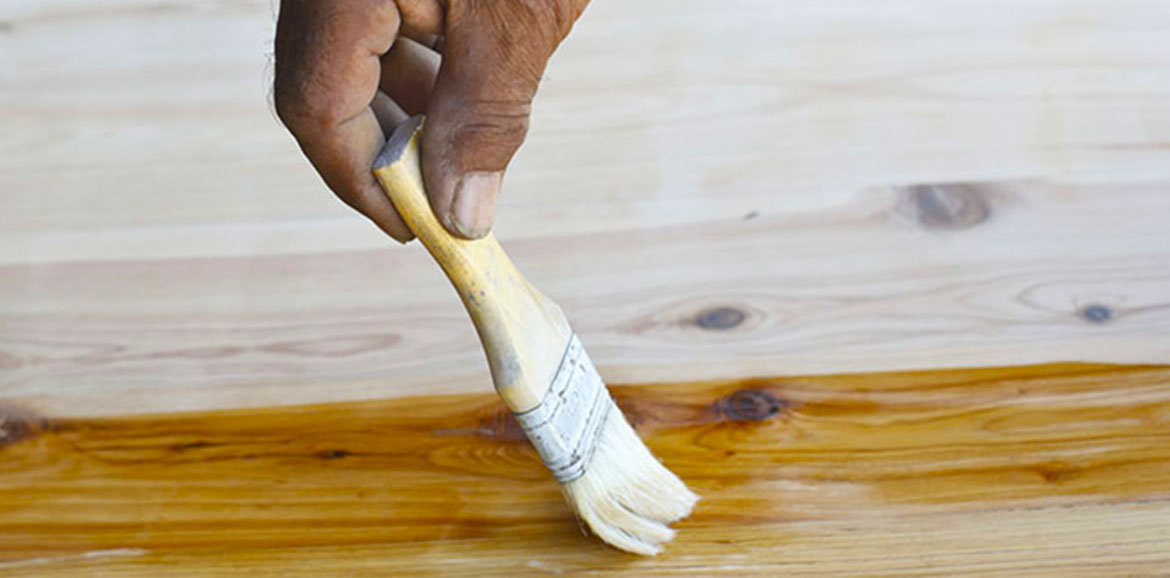The wood used for furniture, flooring & other interior decoration is particularly susceptible to abrasion, scratches & general soiling, as well as water & chemical staining. To protect the sensitive substrate, wood coatings must serve as a strong barrier against external threats. Of course, they must also impart high gloss and other decorative touches.
The most common coatings type is two-component (2K) system, where an acrylic polyol solution is mixed with a polyisocyanate just before use & applied to the substrate. The coating then cures by a combination of solvent evaporation & chemical cross linking to form a durable urethane bond.
UV curable coatings, on the other hand, are one-component (1K) systems that cure by photo initiated polymerization of the acrylate monomers and oligomers in the formulation. These typically do not contain solvents, and cure is instantaneous.
Through careful raw material selection, UV cure coatings formulators can more easily manipulate physical properties, such as chemical and weather resistance, as well as mechanical properties, such as tensile strength and elongation. Controlling these properties enables formulators to create customized coatings that meet specific performance criteria for each application (i.e. excellent abrasion resistance for wood flooring, superior water resistance for wood furniture). In addition to performance benefits, UV cure technology provides processing advantages over traditional solvent borne technology. First, because there are no solvents involved, formulators are able to reduce volatile organic compound (VOC) emissions for simpler EPA compliance. UV cure coatings also dry more quickly than their solvent borne counterparts, speeding production times for increased profitability.
Basics:- Ultra violet light cure in place coatings are applied and immediately cured or polymerized on the substrate. As the name implies, UV cure-in-place technology initiates free-radical curing with UV light.
With UV technology, coatings are cured-in-place using specialty acrylic esters, which include acrylate and methacrylate monomers and oligomers. These specialty acrylic esters offer numerous improvements over conventionally formulated and cured solvent-borne systems, such as low to zero VOC content, improved performance and significantly decreased drying times.
Formulations for UV coatings typically consist of a blend of an oligomer, monofunctional monomer, multifunctional monomer and photoinitiator, as well as additives and pigments. The oligomer imparts most of the basic properties of the final cured material, making it a critical formulation component.
Oligomers:- The three most commonly used oligomer classes in the UV-curable wood coatings industry are urethane acrylates, Epoxy acrylate and polyester acrylates.
Urethane acrylate:- Oligomers are high-molecular-weight, reactive, high-performance oligomers offering superior physical & mechanical properties. Urethane acrylates provide excellent weather ability and are non-yellowing with high gloss, making them ideal for wood coatings.
Epoxy acrylate:- Oligomers are attractive to some formulators because they are more economical, although they tend to yellow with time. Mechanical properties of the epoxy acrylate oligomers are excellent. They provide chemical resistance, abrasion resistance, water resistance and hardness.
Polyester acrylate:- They are a class of oligomers used in UV-curable wood coatings to economically provide superior physical and mechanical properties. Higher priced urethane acrylates can be replaced with the more economical polyester acrylate oligomers without sacrificing performance. Lower priced epoxy acrylates can be replaced with polyester acrylate with the added benefits of better yellowing resistance and weathering characteristics.
These oligomers are more difficult to prepare than the acrylic polyols used in 2K urethanes, which contributes to the high cost of UV-curable formulations. It is even more difficult to prepare acrylated urethane oligomers based on acrylic polyols because their high functionality often leads to gelling or high viscosities. We believe this has contributed to slow growth of UV- curable coatings in applications where excellent UV stability is required, such as automotive clear coats. Other limitations of UV- curable coatings include the absence of a dark cure mechanism and difficulty in spraying and curing 3D parts.
Several companies have recently reported on dual-cure coatings that combine the benefits of UV and 2K systems and overcome some of their limitations. These coatings are based on acrylated polyisocyanates and unsaturated polyester polyols. The UV- curing step is used to obtain tack-free coatings so the parts can be handled, buffed or sanded immediately after UV-cure. Another benefits of achieving an instant, tack- free coating is improved appearance. This is because fewer airborne impurities have time to contact the wet film and cause defects.
The final coating properties however, are achieved by the combination of a UV- curing process and a chemical crosslinking process. The cured films are usually more flexible and adhere better to the substrate than 100% UV-curable systems, presumably because shrinkage is reduced. The dark or thermal cure mechanism provides a means to cure the film in areas not fully exposed to UV light. However, as was the case with conventional UV-curable oligomers, the main polymer backbone is a polyester, not an acrylic resin. This is expected to limit the weatherablity of this coating system.
Visit us at: www.rajadditives.net
Email us: rajspecialityadditives@gmail.com

